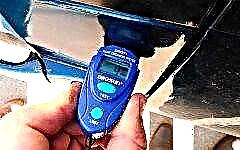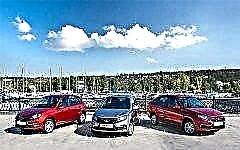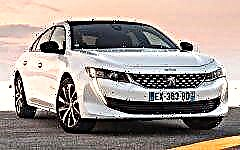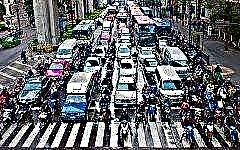

The content of the article:
- Transport rental
- Thai rules
- Vietnamese mess
- The apparent security of Malaysia and the Philippines
The differences between Russian and Asian traffic rules are not significant. They are not in road signs, not in markings and not even in left-hand traffic, but exclusively in the behavior of foreign drivers. Their frivolity constantly leads to collisions, collisions with pedestrians, fines, abuse and the creation of an extremely dangerous, unpredictable traffic environment.
Therefore, before traveling to the countries of Southeast Asia as a pedestrian or a driver on any type of rented transport, you should carefully familiarize yourself with the peculiarities of the movement and the mentality of local citizens.
Transport rental in Southeast Asia

It is very easy to rent a car, scooter or motorcycle in Malaysia, Thailand, Indonesia, the Philippines. In every country you can find an endless number of rental locations with different price ranges. When drawing up a lease agreement, you should carefully study all the points, since additional, paid services may be included in it. You need to take the car no less scrupulously, since all the chips and dents that you did not notice can then be blamed on you.
Thai and Indonesian distributors will take a quick look at the availability of a driver's license and, most likely, will not even ask for a deposit if the rental is paid in full.
In Malaysia, car rental can be called a luxury, and the license will require an international standard, although you can get a local certificate based on the Russian one. Advance booking of transport will help a little to save money, preferably a few weeks before arrival in the country, since prices will skyrocket during the tourist season. You should choose a business class car at the rental offices at the airport, budget models can be found in any other office, of which there are many in the country.
In the Philippines, the rental network is very developed, but only adults with local and international rights can rent a car. Here you can even rent a car with a driver.
Thai traffic regulations

In any city in this country, traffic on the roads will look like a chaotic flickering. There are so many accidents in Thailand that a special disease has appeared, which is ironically called the "Thai tattoo". This is the name of the injuries of people who have been in an accident, locals and tourists who collide equally often. Due to the hot and very humid climate, not only large wounds, but even abrasions, scratches, cuts heal for several months, can start to fester and leave an ugly mark.
In this country, left-hand traffic, and the most active and numerous participants are mopeds and motorcycles. The law obliges their drivers to wear protective helmets, but not everyone does this, despite the threat of a fine. Even with a city speed limit of 60 km / h, and in some sections even 30 km / h, a normal road crossing in a specified place will require agility and courage from pedestrians. The sidewalks themselves are so narrow that, while on it, you can be knocked down by the mirror of a passing vehicle. Usually there are no sidewalks at all.
Thai drivers are not only not aggressive, they are completely serene. They never swear, do not sort things out, do not engage in hand-to-hand combat with the offender. They just drive as they see fit, and not as prescribed by the rules, which is facilitated by the almost complete absence of road signs. They rarely turn on turn signals, never let pedestrians pass anywhere, overtake other drivers on the left, although this is strictly prohibited.
There are also a number of unwritten rules:
- at a traffic light, it is permissible to turn left even at a red signal, but first you must let everyone go to a green signal (sometimes it is forbidden!);
- before the stop line on the road, you will have to skip those drivers who are moving along the crossing road;
- if two cars meet on a narrow road, and one of them beeps, she asks for the right to go first.
Traffic inspectors in Thailand are not in the habit of hiding in bushes or standing in the heat on the road. With a certain frequency, they conduct raids, during which they heartily punish with fines for speeding, lack of helmets, for driving without a license or with a stitched technical inspection ticket.
A tourist stopped by an inspector will need to have a driver's license, preferably Thai. The police in the country are as calm as the rest of the citizens. Inspectors behave correctly, politely, which is also expected in return. If, however, begin purely in Russian traditions with them sarcastically or impudently, then this already threatens with serious proceedings and a significant increase in the size of the fine.
There are very high quality toll roads in Thailand. The cost of using such a route starts from 20-25 baht (about 60 cents), usually 40-80 baht (1.3 - 2 dollars), for which, before entering a paid section, you will need to get a special plastic card at the box office or immediately pay for a section of the road ... Payment is made at the end of the road. All toll tracks have free backup.
The problem with parking is very acute: due to the narrowness of the roads, it is impossible to simply park cars at the side of the road, and it is also forbidden to stop at the yellow markings for public transport and taxis. Locals fearlessly disregard the rules, throwing their machines wherever they get, while tourists will be fined for such actions.
Vietnamese mess

The fact that every year 8 thousand people die in accidents speaks about Vietnamese roads. The National Highway Traffic Safety Committee blames such statistics equally on pedestrians, vehicle owners and law enforcement agencies. All road users systematically disregard the rules, and the police do not make efforts to restore order. For example, during the testing period of a high-speed transit bus in Hanoi, even despite the allocated lane and dividers, mopeds, motorcycles and cars huddled together on the road and did not try to step aside in front of the bus.
This country is also dominated by a variety of two-wheeled vehicles. Outside the city, it has its own lane, which is an asphalt roadside. They have the right to enter car lanes, but will have to give an advantage to cars. That is, being on "foreign territory", two-wheelers always need to be on the alert and prepare to dive into their lane, in order, for example, to enable the car to overtake a neighbor. In the city, the roads have 5 lanes in each direction, along which all transport, from bicycles to trucks, sweeps.
It is not uncommon to meet vehicles driving along the side of the road ... on the opposite lane. And in Vietnam they treat this absolutely calmly - you never know, a person has forgotten something, he must return. It must be admitted that such a driver will drive very carefully and politely, and therefore the drivers in their lane will mutually press against the center so as not to interfere.
The most aggressive on the road are buses, which always move at maximum speed, dashingly overtaking neighbors and constantly honking. They should definitely give way, and pedestrians shouldn't even try to cross the road in front of the bus.
Small trucks are next in the degree of unpredictability, compared to which Russian minibus drivers are angels. Nimble trucks do not include turn signals, jump out of the most unexpected corners, can turn right in the middle of the lane and jerk in the opposite direction.
The task of a two-wheeled vehicle is to interfere with a four-wheeled vehicle as little as possible, but pedestrians have the most difficulty. No one will ever miss them, neither a two- or four-wheeled vehicle, nor at a pedestrian crossing, nor, even more so, outside it. However, pushing pedestrians is also somehow not accepted. Therefore, people go about their business where they need to, and transport simply flows around them. The main rule of a pedestrian is to behave as predictably as possible, not to run, not to change the trajectory, then the road crossing will be mutually safe.
The hardest part is at Vietnamese crossroads, the driving rules of which are understood rather intuitively. If there is a traffic light at the intersection, it is happiness for everyone. But if it is not there, then you need to act in this way:
- first of all, skip the trucks, which are too difficult in the dense Vietnamese traffic;
- join a group of drivers driving in the direction you want. The essence of this action is that a single car will not be allowed at the intersection, unlike a bunch of cars. That is, the rule of crossing an unregulated intersection can be reduced to the following conclusion: whoever is followed by the crowd is allowed to pass. This principle is also applicable to circular motion.
Summing up the overview of the key traffic rules in Vietnam, it should be warned that only local driving licenses are valid in the country. An international certificate has no force here, let alone a Russian one. You just need not to stand out from the stream, not to rush, to be correct, and then none of the police officers will pick on you.
The apparent security of Malaysia and the Philippines

Malaysia and the Philippines are not very different from their neighbors: an abundance of two-wheeled vehicles, good roads, a minimum of road signs and a maximum of chaos.
Road signs are presented both in an international format and in a local, national language. But the writing system of Malaysia is very similar to the Latin alphabet, so it will not be difficult to understand the signs.
But the main problem of the Philippines is many kilometers of traffic jams, although the rest of the local traffic compared to other announced countries can be called almost normal. There are several times less two-wheeled transport here, since the dominant role is assigned to buses and jippies.
The Jeepie is the national Filipino vehicle, which is a hybrid of a minivan with a classic American open jeep.
American troops abandoned their "Wilis" here during the Second World War, and handicraftsmen turned them into such a specific design. Jeepies are used for personal purposes or as public transport, painted in all colors of the rainbow and plying as a minibus. You can find on the roads and carts pulled by a variety of animals, and even a taxi, functioning from coconut oil.
The behavior of Filipino drivers in general does not differ from their neighbors; it seems more adequate precisely because of traffic jams, which do not allow them to exceed speed, overtake or make sharp maneuvers. Pedestrians walk wherever they want in the same way, and motorists do not know about the existence of turn signals. And a foreigner driving just can involuntarily provoke an accident precisely by observing the rules - for example, getting hit in the rear bumper while stopping at a traffic light.
Conclusion
To summarize, walking or wheel travel in Southeast Asia can be called a quest, a survival game, and an interesting adventure. Hot-tempered, faint-hearted people, as well as newbies behind the wheel, are not recommended to drive in these countries, so as not to spoil their mood from the trip and not understand half of their vacation about a road accident.
For those who want to see the suburbs, explore the insular part, it is better to rent a moped, which is both cheaper and passable on country roads. Large cities, especially their centers, are preferable to visit as part of an organized excursion in order to stay safe and sound.











